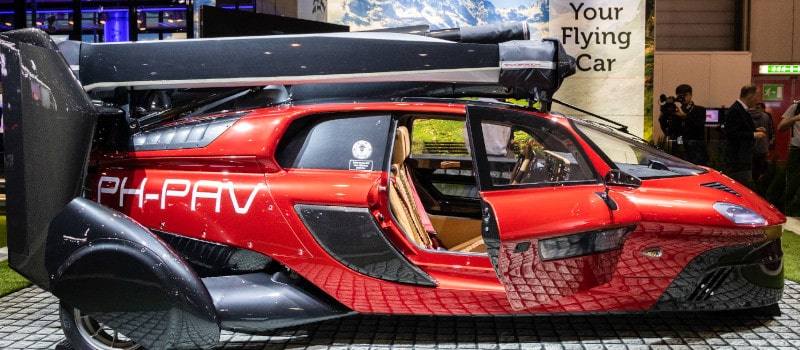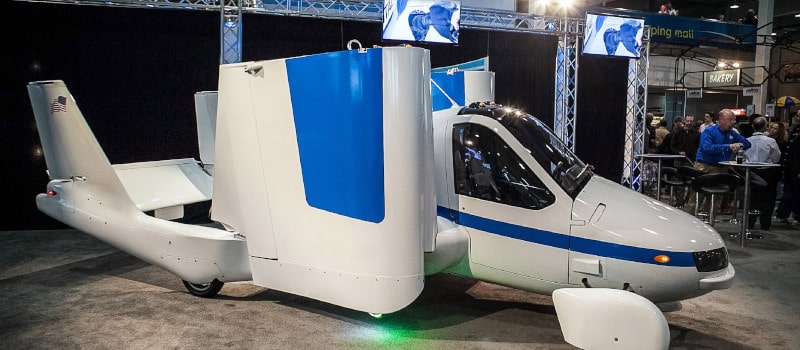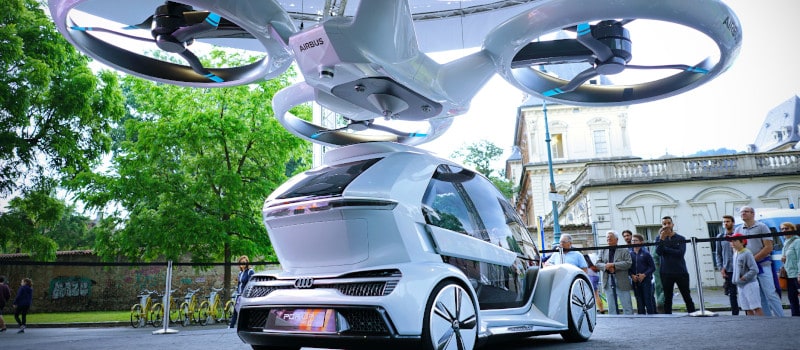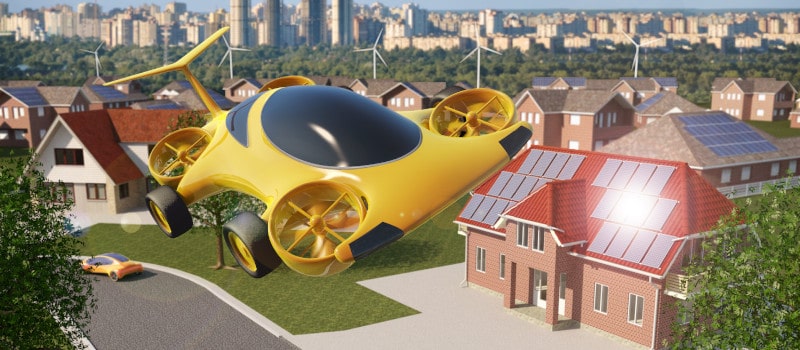
Will we ever really have flying cars?
11th Sep, 2019
If you remember classic sci-fi movies and shows like Back To The Future, Blade Runner, the Fifth Element, and the Jetsons, you’ll remember one of the staple futuristic technologies they all had in common – flying cars. It’s a timeless shorthand for sci-fi tech, and one that might still seem a very long way off from the real world. The thing is, technological advancement in real life is incremental, rather than sudden and dramatic, making it easy to forget that we’re living in a world where self-driving cars and ‘smart motorways’ are already a reality. In other words, in many ways the future is already here. But how close are we to flying cars?
Well, that depends on your perspective. If you’re just thinking about the development of the actual machines themselves, they’ve actually been around for some time now. Multiple flying car prototypes have been built (albeit at staggering cost) by boutique or specialist companies all around the world. However, we’re yet to see a widespread commercial or industrial run, and those neat little organised rows of traffic are likely years off yet, if not decades. Sustainability, safety and infrastructure are all major concerns surrounding their development, and that’s not to mention how companies like ours will evolve when we come to scrap your car!
So, where are we now with flying cars, and where is the future headed?
What do flying cars need?
Even when implemented gradually, the evolution of cars from ground-based vehicles to airborne ones is a hugely dramatic change, and requires a big shift in our transport infrastructure if they’re going to be properly accommodated for. This in turn means that flying cars need to be designed in a certain way if they’re ever going to become viable. Here’s a couple of things that they’ll require:
VTOL capability
Vertical Take Off and Landing is already a capability of many advanced fighter jets, and it’ll be a bread-and-butter requirement for flying cars. After all, we can hardly clear enough space in every major city for dedicated runways, and there are countless safety implications for taking flight as you’re barrelling down the M6. No, most flying cars will require landing pads rather than runways, and that means they’ll need to be VTOL.
High capacity batteries
There’s already a massive amount of concern about the effect of our transportation systems on the environment, so it’s overwhelmingly likely that all flying cars will need to be all-electric. The trouble there is that right now, on average batteries weigh 70 times more than fuel. Therefore, we’ll have to see some big advancements in that area before flying cars become viable. As things stand, the range of electric flying cars would be severely limited – so what would be the point in them?

Special charging infrastructure
Just like any other vehicle, electric flying cars will need a place to ‘refuel’, and for that to happen we’ll need a dedicated charging infrastructure capable of doing so. Right now, it’s proving to be a challenge just getting the charging points in place for ground-based electric vehicles, so this might prove to be a particularly big hurdle. (That’s to say nothing about the increased demand on the National Grid!)
Air traffic control
While individual flying cars will need to be capable of navigating themselves to an extent, it’s likely that there will also need some level of official and logistical oversight. What form exactly that will take, and who will be responsible for implementing it, remains to be seen!
The practical and logistical problems
In a way, the construction of flying cars is a curious feedback loop – new infrastructure needs to be properly tailored to them, and they need to be designed so fit within the boundaries of the new infrastructure. For example, the very nature of flying cars immediately poses a logistical problem for designers, namely in that the vehicles have to copy with official regulations for both cars and airplanes. Both are very strict for safety reasons, and might not always be directly compatible with each other in certain aspects.
One such aspect is weight. Flying cars will need to generate enough power for the drivetrain, but also for their wings or rotor blades. They’ll also probably need separate controls for driving and flying, and that’s if they’re being piloted by a human at all. As a result of all this, weight might end up being a big problem. The aerospace and automotive industry both have very different specifications for weight, and flying cars will somehow have to toe the line between them.
Some experts think this might prove to be too much of a challenge; as one critic put it, a vehicle that’s reliably safe and robust enough for the ground may well be too heavy to efficiently take to the air. In other words, designers might have to choose between building a very slow car, or a very unstable airborne vehicle.
That leads us onto the next big question – perhaps the biggest. Namely, how safe is this? The answer is: right now, not very. After all, safety concerns apply not just to people within the flying car itself, but also for everyone on the ground. When a regular car suffers a mechanical failure, it slows to a stop. When a flying car suffers a mechanical failure, even a temporary one – what happens then?
Tech mogul Elon Musk perhaps said it best: “Even in autopilot, and even if you’ve got redundant motors and blades, you’ve still gone from near-zero chance of something falling on your head to something greater than that.”

Whatever the assurances from manufacturers, even a tiny chance might be deemed unacceptable for many parts of the UK. It’s hard to see flying cars being welcomed with open arms in Glasgow, for example, after a horrifying helicopter crash in 2013 which claimed the lives of 10 people. However rare these instances are, it’s worth bearing in mind that the chances of it happening are multiplied several times over with every flying car travelling over the city.
Some manufacturers are already suggesting measures to ease these concerns – one Chinese company, for example, is suggesting that every prototype is equipped with a parachute. But then the problem remains – how do you control where the vehicle lands? Even a slowly-falling car is still large, heavy, and dangerous, and if it drifts in the direction of a high-rise building, or a waiting line of immobile traffic on the ground below, it’s hard to see why a parachute will do much to alleviate safety concerns.
Interestingly, one element of sci-fi films might end up being true to form – flying cars will likely have to stick to pre-approved flight corridors, arranged strategically over low-population areas of land to pose minimal risk to anyone on the ground below. It’s still far from a perfect solution, though, as the question remains of who will own this land, how it will be maintained, and what additional measures will be put in place.
The legal obstacles
We’ve touched on one of the biggest aspects of this already above – the manufacturers of flying cars will need to make sure they’re compliant with two (sometimes competing) sets of regulations. But there are also laws which apply to their general operation, too, and it’s these same laws that mean we’ve got some bad news for you: you’re probably not going to own and pilot your own flying car.
The transformation of a ground-based car into a flying model will mean that its legal classification changes accordingly, from a land-based to an aerospace vehicle. That means you’ll not only need to own a normal driver’s licence, but you’ll almost certainly need to be a qualified pilot too. Pilot’s licences aren’t cheap, and that almost immediately puts flying cars far from the realm of consumer transport for some decades at least – possibly forever.

There’s also the question of what happens with insurance, and who will provide cover. Possibly, we’ll start to see specialist firms cropping up, or possibly it will fall under the remit of existing motoring or aviation firms. Who’s to say?
Plus, there’s the matter of what administrative niche flying cars will occupy within the British government. To what extent will they be affected by changes in aviation or motoring law? Which administrative body will be responsible for monitoring them – the Driver and Vehicle Licensing Agency, or the Civil Aviation Authority? Would we need to create a new body entirely?
Whoever ends up making the rules on flying cars has an unenviable job, as they’d also need to work out how existing legislation would be applied. If the range of flying cars improved, how far would they be legally permitted to travel? Would drivers still be legally required to carry a breathalyser and a high-vis jacket if they entered French airspace? And how would we ensure that flying cars don’t interfere with existing aviation flightpaths? Think of the chaos caused by one tiny drone at Gatwick in 2018!
Realistically, what can we expect of flying cars?
If you’re excited about the vision of a future with columns of flying cars gliding across the skies, you’ll be happy to hear that some of the issues we outlined above are already being addressed. As well as small, specialist companies, there’s no shortage of recognisable tech giants who want to make flying cars a reality, not least because of the fantastic business opportunities it affords them. Uber wants flying ride-sharing vehicles in our skies by 2020, which is seen by some as far too optimistic (especially as that first announcement was a relatively long time ago now.) But it’s joined by names like Airbus, Google and Toyota, all of whom are contributing their world-class and innovation to the technology.
As we mentioned above, though, your dreams of owning your own personal flying car are probably going to remain firmly in the realms of fantastic. Realistically, most flying cars (at least initially) would probably be owned by businesses. Think of Uber’s business model. You wouldn’t buy a flying car – you’d rent one for short periods of time, or individual journeys. (In fact, it’s visions like these which might ultimately end up contributing further to the current decline in car ownership.)
The corporate vision is one of ‘shared mobility services’, and the machines they’ll use will probably more closely resemble modern drones than anything you’d see on an episode of the Jetsons. Picture fleets of small, sleek machines that are basically road-capable helicopter-taxis, transporting private and business customers between airports, city centres and major transport hubs.

So who would fly these cutting-edge vehicles? Nobody. At least, not humans. Pilot’s licences are expensive and time-consuming to obtain, making them uneconomical for corporations, and the issue of human error would be a very real and pressing issue for the budding industry. Instead, flying cars would probably be autonomous, piloted by AI and algorithms. This would minimise human error, and enable vehicle-to-vehicle communication – allowing driverless flying cars to navigate seamlessly around each other in midair, with no misinterpreted hand gestures, sudden braking or loud cursing.
This isn’t as far fetched as you might first think – right now, a sizeable proportion of modern mid-air aviation tasks are actually performed by a computer, which is guided by the pilot’s input and intuition. The challenge for flying cars is how to get to a stage where the AI doesn’t need that input.
Of course, the big trouble here is that this opens up whole new legal problems with self-driving cars. To sum up one of the biggest ones – if an accident happens, who claims legal culpability? The manufacturer, the designer, or the passenger? Right now, there’s no easy answer to this, and may never be one. Everything relevant to ground-based self driving cars also goes for self-driving flying cars – with added complications due to the three dimensional nature of movement.
So how close are we to achieving realistic aerial automobiles?
Closer than you might think! Working prototypes have been making test flights for well over 10 years now, and they’re still regularly being exhibited at car shows. There are a number of competing models from a growing number of specialist companies, and what’s more, the Dubai Road and Transport Authority aims to launch its first fleet of flying taxis by the end of this year! (True, it’s certainly not a consumer range, and for the time being it’s likely to be exclusive to high-level business executives – but it’s still an important first step.)
Plus, we’ve already mentioned drones, and you may well have heard of Amazon’s long-term plan to make large scale deliveries using fleets of branded helicopter-robots. The way things are developing at the moment, some see a future with flying cars as just an up-scaled version of that plan. Granted, there’s a lot of hurdles to overcome, and the practical, logistical and legal problems are myriad. However, it’s worth bearing in mind that the world’s first plane made its debut as recently as 1903, and the world’s first car only a few decades before that. Now, it’s difficult to imagine a world without them – so who knows what the future holds?

Whatever the case, ground-level vehicles aren’t going away anytime soon. That’s good news for us – and good news for you, as it’s never been easier to scrap your car! All we need is your car reg and postcode to provide you with a free, no-obligation instant online quote. Wondering how much your car is worth? Couldn’t hurt to look, could it?